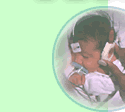

 |
Five Facts on Hearing Loss in Children
1) Everyday in the United States, approximately 33 babies (1 to 3 infants per 1,000) are born with significant hearing loss.
2) Hearing loss is the most common congenital disorder in newborns; 20 times more prevalent than phenlyketonuria (PKU), a condition for which all newborns are currently screened.
3) Today, the average age that children with hearing loss are identified in the U.S. is 12 to 25 months of age. When hearing loss is detected late, critical time for stimulating the auditory pathways to hearing centers of the brain is lost. Speech and language development is delayed, affecting social and emotional growth and academic achievement. The cost of late identification is not only in real health care and public education dollars, but also in the frustration borne by parents and these children who lack appropriate language skills to compete academically and ultimately in today's "information age" job market.
4) Only about 25% of the babies born in the U.S. are born in hospitals with universal newborn hearing screening programs.
5) It is estimated that another 3 infants per 1,000 are born with moderate hearing loss (a total of 6 infants per 1,000, or over 60 babies born a day) could be identified and receive needed habilitation with the implementation of early hearing detection and intervention (EHDI) programs.
Back to Early
Hearing Detection & Intervention Action Center
Frequently
Asked Questions
Issue Brief: Early
Hearing Detection & Intervention

